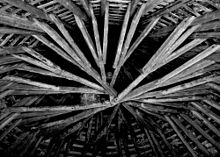Papa Westray
| Papa Westray | |
|---|---|
| Papa Westray Beach | |
| Waters | North Sea |
| Archipelago | Orkney Islands |
| Geographical location | 59 ° 21 '22 " N , 2 ° 53' 36" W |
| length | 7 km |
| width | 2 km |
| surface | 9.18 km² |
| Highest elevation | North Hill 49 m |
| Residents | 90 (2011) 9.8 inhabitants / km² |
| Knap of Howar | |
To Scotland owned small island Papa Westray (also Papay or in the sagas Papa Meiri - called - the larger of the priests Islands) is next to North Ronaldsay to the northern islands of Orkney and is located about 40 km north of Kirkwall on Mainland . In 2011, 90 people lived on the island.
geography
With a length (north-south) of seven and a maximum width of two kilometers, it has a size of 9.18 km². The highest point is the North Hill with 49 m, which is located in a bird sanctuary and drops steeply into the sea on the cliffs of Mull Head . The island consists of the Rousay Flags group of Middle Old Red Sandstone , on which fertile loams have formed. In the Bronze Age, the island was divided into a north and a south half by a gairsty (a district boundary in the form of an earth wall, such as that preserved on North Ronaldsay , for example ) that had been preserved in remains .
Papa Westray is separated from its much larger sister island Westray by the two to three kilometers wide Papa Sound . This is also where the ferry and flight connections to the main island Mainland run. The flight between Papa Westray and Westray is the shortest scheduled flight in the world with a length of 2.8 km and a flight time of two minutes .
Surname
The name "Papa" indicates the presence of early Christian missionaries - we are talking about Bonifacius and Triduana (or Tredwell) - and monks; The remains of their churches can still be seen today. In the cemetery lies one of the rare hogbacks , a tombstone from the 12th century.
Attractions
The island's attraction is the almost 6,000 year old Neolithic Knap of Howar or Hower, on the west coast on Holland Farm, whose 1.6 m high masonry is impressive. This Neolithic complex was buried under 2.5 m high sand for a long time and is therefore well preserved. The name is derived from Old Norse 'howe', hill, and 'knappr', rock summit, but here in the meaning of English. 'knob' from (the rounded hill that stands out in the flat - only a few meters above sea level - surroundings).
Another attraction is the Holland Farm with a manor house, horse engine house , dovecote and other farm buildings in the middle of the island . Parts of the manor house and some functional buildings such as the horse engine house , the dovecote or the remote foundations of a small post mill today form a small, interesting museum about the history of the farm and the island community.
Holland Farm, the "Farm on the High Land" (high farm), was the seat of Colonel Thomas Traill of Holland in the 17th century, who was known as Germany Thomas as an officer of rank under Gustav Adolf . In unbroken local tradition, Traill is the author of the song Oh! my Love's in Germany , in which his wife Mariota aka May Craigie praises her love for the man fighting on German soil who (like many Scots probably as an artilleryman) served in the Stargate's Corps , the Scottish volunteer association of the Green Brigade in the Thirty Years War . The song is considered to be one of the oldest, relatively precisely datable folk songs from the Nordic culture of Scotland.
Transport and tourism
The island is served daily by modern ro-ro ferries operated by Orkney Islands Ferries and served at least once a day by regional airline Loganair via the world's shortest scheduled flight connection from the island of Westray, 2.5 km away. On October 31, 2016, the one millionth passenger was welcomed on the route, which has been in operation since 1967.
Today, the Papay Coop , the residents' cooperative with the Beltane Hotel & Hostel (privately operated hostel within the Scottish youth hostel organization SYHA), takes care of the supplies for the islanders as well as the tourists .
Footnotes
- ↑ 2011 census data
- ↑ horse engine house refers to a kind of horse-powered göpelwerk , which was used to mechanize various work processes on large farms. Usually these were threshing and grinding mechanisms driven by them. As with the Holland Farm , pumps, chaff and chipping mills (sawmills in more wooded areas of Scotland) could also be switched on via transmission belts.
- ↑ The doocot from Holland House represents the rarer form of a rectangular outbuilding in Scotland, as can only be found on Orkney at Melsetter House / Hoy . Usually doocots buildings were beehive-like in appearance (compare for example the Doocot of Rendall on the mainland or the most famous one in the grounds of Ravenscaig Castle .) Pigeon keeping for food supplement and communication ( carrier pigeons ) was common on the islands until the late 19th century.
- ↑ World's shortest flight celebrates its millionth passenger , in: The Guardian , November 1, 2016, accessed November 1, 2016
Web links
- Location of Papa Westray Island
- http://www.papawestray.co.uk/papay/development_plan.html Development plan of the cooperative



